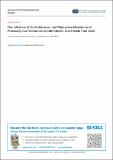| dc.contributor.author | Staerz, Anna | |
| dc.contributor.author | Seo, Han Gil | |
| dc.contributor.author | Klotz, Dino | |
| dc.contributor.author | Kim, Dennis S | |
| dc.contributor.author | LeBeau, James M | |
| dc.contributor.author | Tuller, Harry L | |
| dc.date.accessioned | 2022-05-19T17:29:41Z | |
| dc.date.available | 2022-05-19T17:29:41Z | |
| dc.date.issued | 2022-04-01 | |
| dc.identifier.uri | https://hdl.handle.net/1721.1/142617 | |
| dc.description.abstract | <jats:p>While Cr poisoning of the oxygen reduction reaction (ORR) at SOFC cathodes is widely agreed to involve deactivation of oxygen exchange sites, the degradation mechanism remains ambiguous. Here, we selected an alternative cathode material Pr<jats:sub>0.1</jats:sub>Ce<jats:sub>0.9</jats:sub>O<jats:sub>2−</jats:sub>
<jats:inline-formula>
<jats:tex-math>
<?CDATA $\delta ,$?>
</jats:tex-math>
<mml:math xmlns:mml="http://www.w3.org/1998/Math/MathML" overflow="scroll">
<mml:mi>δ</mml:mi>
<mml:mo>,</mml:mo>
</mml:math>
<jats:inline-graphic xmlns:xlink="http://www.w3.org/1999/xlink" xlink:href="jesac67b2ieqn1a.gif" xlink:type="simple" />
</jats:inline-formula> free of Sr segregation, to systematically investigate the effect of Cr-induced degradation in ORR. We expand on our previous studies in which the acidity/basicity of binary additives was found to be a strong indicator of the rate of oxygen surface exchange, by electrochemically investigating the ORR activity of the PCO cathode by impedance spectroscopy. Serial infiltration with acidic Cr-based oxides was found to degrade ORR activity as reflected in a 20-fold increase in area specific resistance (ASR) without corresponding changes in activation energy, with the opposite trend obtained with Ca-based oxides. Detected changes in total capacitance, attributed to changes in surface capacitance, also suggest depressed/enhanced PCO surface redox behavior with Cr/Ca-based infiltrants. Taken together, these results point to a more universal source of ORR poisoning/activation, based on acidity/basicity, rather than physical blocking of active sites. With this improved understanding, one can expect progress to be made in the coming years in optimizing means for protecting catalytic surfaces from degradation and/or improving their performance.</jats:p> | en_US |
| dc.language.iso | en | |
| dc.publisher | The Electrochemical Society | en_US |
| dc.relation.isversionof | 10.1149/1945-7111/ac67b2 | en_US |
| dc.rights | Creative Commons Attribution-NonCommercial-NoDerivatives 4.0 International Licens | en_US |
| dc.rights.uri | http://creativecommons.org/licenses/by-nc-nd/4.0/ | en_US |
| dc.source | IOP Publishing | en_US |
| dc.title | The Influence of Cr-Additives on the Polarization Resistance of Praseodymium-Doped Ceria Cathodes for Solid Oxide Fuel Cells | en_US |
| dc.type | Article | en_US |
| dc.identifier.citation | Staerz, Anna, Seo, Han Gil, Klotz, Dino, Kim, Dennis S, LeBeau, James M et al. 2022. "The Influence of Cr-Additives on the Polarization Resistance of Praseodymium-Doped Ceria Cathodes for Solid Oxide Fuel Cells." Journal of The Electrochemical Society, 169 (4). | |
| dc.contributor.department | Massachusetts Institute of Technology. Department of Materials Science and Engineering | |
| dc.relation.journal | Journal of The Electrochemical Society | en_US |
| dc.eprint.version | Final published version | en_US |
| dc.type.uri | http://purl.org/eprint/type/JournalArticle | en_US |
| eprint.status | http://purl.org/eprint/status/PeerReviewed | en_US |
| dc.date.updated | 2022-05-19T17:22:33Z | |
| dspace.orderedauthors | Staerz, A; Seo, HG; Klotz, D; Kim, DS; LeBeau, JM; Tuller, HL | en_US |
| dspace.date.submission | 2022-05-19T17:22:34Z | |
| mit.journal.volume | 169 | en_US |
| mit.journal.issue | 4 | en_US |
| mit.license | PUBLISHER_CC | |
| mit.metadata.status | Authority Work and Publication Information Needed | en_US |
